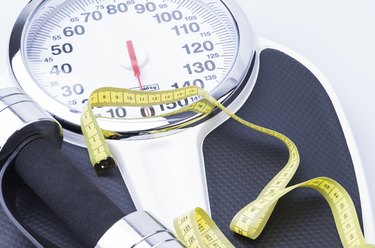
Most workouts, especially those that don't require machines or special equipment, are effective no matter how tall you are or how much you weigh. Depending on your fitness goals, however, it is wise to choose specific exercises based on your body size. You can also use your height and weight to calculate your body mass index, BMI, which will tell you how your size relates to other people's of your height.
BMI
Video of the Day
Calculating your BMI can help determine whether you have overweight, which will give you an indication of how much you may need to exercise. To figure out your BMI, multiply your weight in pounds by 703. Then multiply your height in inches by itself. Divide the first figure by the second. According to the National Heart Lung and Blood Institute, a BMI of less than 18.5 indicates a person is underweight, 18.5 to 24.9 indicates normal weight and more than 25 is classified as overweight. Regardless of how tall you are or how much you weigh, you can exercise to slim down if you have a BMI of 25 or greater. To lose weight, the American Council on Exercise recommends doing a combination routine of aerobics, strength training and flexibility for at least 45 minutes per day on five or six days per week.
Video of the Day
Calories
Your height may not have much of an impact on how many calories you burn with exercise, but your weight does impact that amount. According to MayoClinic.com, a 160-lb. person can burn close to 600 calories by jogging for 60 minutes at a speed of 5 mph, but a 240-lb. person doing the same activity for the same amount of time will burn closer to 900 calories. Thus, if you're light but want to burn as many calories as possible, you may have to intensify your workouts or exercise for longer periods of time.
Machines
If you are especially tall or short, you might run into issues with using certain pieces of exercise equipment. For example, treadmills and elliptical machines usually have hand grips around chest level for most people, but you may find them uncomfortable to hold if you have to reach too far up or down. You can solve the problem by doing the workouts without holding the grips, or you can simply choose to eschew machinery and equipment in favor of calisthenics or a more basic form of aerobics, like jogging or biking.
Considerations
If you have obesity, which is defined as having a BMI of 30 or greater, some exercises may not be safe for you to do, so it's advisable to speak with your physician before beginning any new workout program. Do the same if you haven't been active for a long time, no matter what your size. A physician or personal trainer can also give you personalized recommendations on exercises that you might find most comfortable and enjoyable.